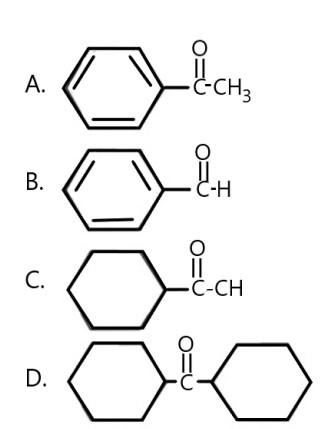
Answer
426.9k+ views
Hint: Carbonyl compounds have \[CO\]/ \[( - C = O)\] groups in them. And syn-anti isomerism is just another name for cis-trans geometrical isomerism. In cis-isomerism similar groups (atoms/molecules), are on the same side, and in trans-isomerism, similar groups are at opposite sides (${180^ \circ }$apart).
Complete step-by-step answer:
Following the given hint we get the basic idea about the cis-trans isomerism. Now to get our answer we have to draw the corresponding oxime for each case and look for the syn-anti isomerism. The reaction in each case is similar as we are using the same reagent that is ${\text{N}}{{\text{H}}_{\text{2}}}{\text{OH}}$ and every reactant has the same functional group i.e., \[( - C = O)\] (the functional group governs the chemical property of any compound it is attached to). Therefore, in each case ${{\text{H}}_{\text{2}}}{\text{O}}$molecules will release.
A) In the first case, acetophenone is reacting with oxime and is being released, the product form is:
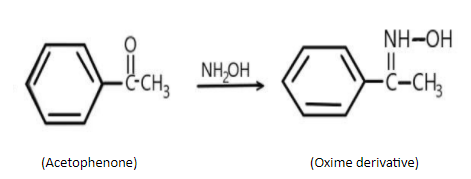
B) In 2nd reaction, we have, benzaldehyde reacting with oxime, and forming the corresponding oxime derivative, the reaction can be written as;
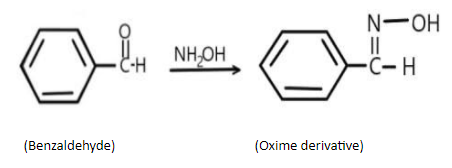
C) In 3rd reaction, we have cyclohexyl acetone reacting with oxime, its oxime derivatives can be written as,
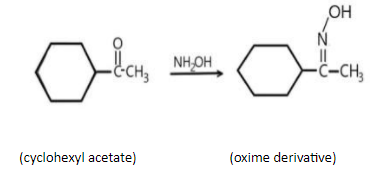
D) In the 4th reaction we have di- cyclohexyl ketone reacting with oxime, the oxime derivative can be written as;
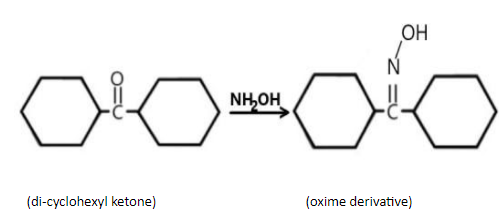
By looking at the oxime derivative of all the given compounds we can conclude that option (D) will not form the syn-anti isomerism, because ketones having the same acyl group bonded with the carbonyl (\[( - C = O)\]) group does not show syn-anti isomerism.
Hence, the correct answer is option (D) i.e., the di-cyclohexyl ketone.
Additional information:
We can sum up cis-trans isomerism in the following three requirements.
i) The first condition is that rotation must not be allowed in a compound. We know that any compound is present in a 3-dimension state in the ‘real world’, therefore it can so happen that the compound will undergo rotation and change its orientation. Hence to get a stable cis-trans isomer the rotation of the compound must be prohibited, that’s why we look for double bonds in a compound.
ii) However, having a double bond only restricts the rotation, it does not confirm cis-trans isomerism.
iii) The second condition is that there must be at least two non-identical groups on both sides of the double bond.
iv) If all groups are different in a compound (say A, B, C, D) then, by keeping the position of one group (say, fixing the position of the group ‘A’), we can assign one of the conformations as cis(assuming A and B, on one side as cis) and the other as trans (A and B on different sides).
Note: We just saw that syn-anti isomerism can be called as cis- trans isomerism, but cis-trans isomers can also be written as Z-E isomers, respectively. That is why it is important to keep a note of all the other terms related to an isomer.
Complete step-by-step answer:
Following the given hint we get the basic idea about the cis-trans isomerism. Now to get our answer we have to draw the corresponding oxime for each case and look for the syn-anti isomerism. The reaction in each case is similar as we are using the same reagent that is ${\text{N}}{{\text{H}}_{\text{2}}}{\text{OH}}$ and every reactant has the same functional group i.e., \[( - C = O)\] (the functional group governs the chemical property of any compound it is attached to). Therefore, in each case ${{\text{H}}_{\text{2}}}{\text{O}}$molecules will release.
A) In the first case, acetophenone is reacting with oxime and is being released, the product form is:

B) In 2nd reaction, we have, benzaldehyde reacting with oxime, and forming the corresponding oxime derivative, the reaction can be written as;

C) In 3rd reaction, we have cyclohexyl acetone reacting with oxime, its oxime derivatives can be written as,

D) In the 4th reaction we have di- cyclohexyl ketone reacting with oxime, the oxime derivative can be written as;

By looking at the oxime derivative of all the given compounds we can conclude that option (D) will not form the syn-anti isomerism, because ketones having the same acyl group bonded with the carbonyl (\[( - C = O)\]) group does not show syn-anti isomerism.
Hence, the correct answer is option (D) i.e., the di-cyclohexyl ketone.
Additional information:
We can sum up cis-trans isomerism in the following three requirements.
i) The first condition is that rotation must not be allowed in a compound. We know that any compound is present in a 3-dimension state in the ‘real world’, therefore it can so happen that the compound will undergo rotation and change its orientation. Hence to get a stable cis-trans isomer the rotation of the compound must be prohibited, that’s why we look for double bonds in a compound.
ii) However, having a double bond only restricts the rotation, it does not confirm cis-trans isomerism.
iii) The second condition is that there must be at least two non-identical groups on both sides of the double bond.
iv) If all groups are different in a compound (say A, B, C, D) then, by keeping the position of one group (say, fixing the position of the group ‘A’), we can assign one of the conformations as cis(assuming A and B, on one side as cis) and the other as trans (A and B on different sides).
Note: We just saw that syn-anti isomerism can be called as cis- trans isomerism, but cis-trans isomers can also be written as Z-E isomers, respectively. That is why it is important to keep a note of all the other terms related to an isomer.
Recently Updated Pages
Who among the following was the religious guru of class 7 social science CBSE

what is the correct chronological order of the following class 10 social science CBSE

Which of the following was not the actual cause for class 10 social science CBSE

Which of the following statements is not correct A class 10 social science CBSE

Which of the following leaders was not present in the class 10 social science CBSE

Garampani Sanctuary is located at A Diphu Assam B Gangtok class 10 social science CBSE

Trending doubts
A rainbow has circular shape because A The earth is class 11 physics CBSE

Which are the Top 10 Largest Countries of the World?

Fill the blanks with the suitable prepositions 1 The class 9 english CBSE

What was the Metternich system and how did it provide class 11 social science CBSE

How do you graph the function fx 4x class 9 maths CBSE

Give 10 examples for herbs , shrubs , climbers , creepers

The Equation xxx + 2 is Satisfied when x is Equal to Class 10 Maths

What is BLO What is the full form of BLO class 8 social science CBSE

Change the following sentences into negative and interrogative class 10 english CBSE

